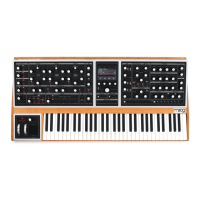46
LOW FREQUENCY OSCILLATORS
Just as the Oscillator is the primary sound source found in a synthesizer, the Low Frequency Oscillator
(LFO) is often the primary source for adding modulation. Whenever one synthesizer module inuences
the behavior of another module, that is modulation. As the name suggests, LFOs are Oscillators that
have a low-frequency operating range. LFOs are ideal for introducing a controlled, cyclic modulation
that can be used for adding vibrato (modulating the pitch of the oscillator), for example, but it goes
far beyond that. Moog One provides four independent LFOs that deliver extensive modulation control,
plus a host of modulation parameters that open new avenues for creative sound design. Plus, each
LFO can be individually sync’d to different timing divisions of the Master Clock for an astounding
polyrhythmic performance.
RATE (0 to 10)
The RATE knob sets the speed of the LFO; slower values to the
left, faster values to the right. The range of available frequencies
is determined by the RANGE parameter in the LFO More page.
Additionally, when the LFO is sync’d, the RATE knob is used to
select a timing division of the Master Clock. The RATE knob LED
will ash at the current setting.
WAVE (TRIANGLE, PULSE, SAWTOOTH, S-H)
The WAVE button cycles through the four categories of LFO
waveforms: Triangle / Sine, Pulse, Saw / Ramp, and
Sample-Hold / Noise. The nal wave shape is determined by the
VARIATION parameter found on the LFO MORE page.
TRI / SINE
(TRIANGLE to SINE)
This option provides both a Triangle wave and a Sine wave. Changing
the value of the VARIATION parameter will provide a transition between
the Triangle wave and a Sine wave.
PULSE
With Pulse selected, changing the value of the VARIATION parameter in turn changes the pulse width,
or duty cycle, of the wave.
SAW / RAMP
(SAWTOOTH to RAMP)
This option provides both a Sawtooth wave and a Ramp wave. Changing the value of the VARIATION
parameter will provide a transition between the Sawtooth wave and a Ramp wave.
S&H / NOISE
(SAMPLE & HOLD to NOISE)
For the S&H (Sample & Hold) wave, changing the value of the VARIATION parameter will provide a
transition between the S&H wave and Noise.

